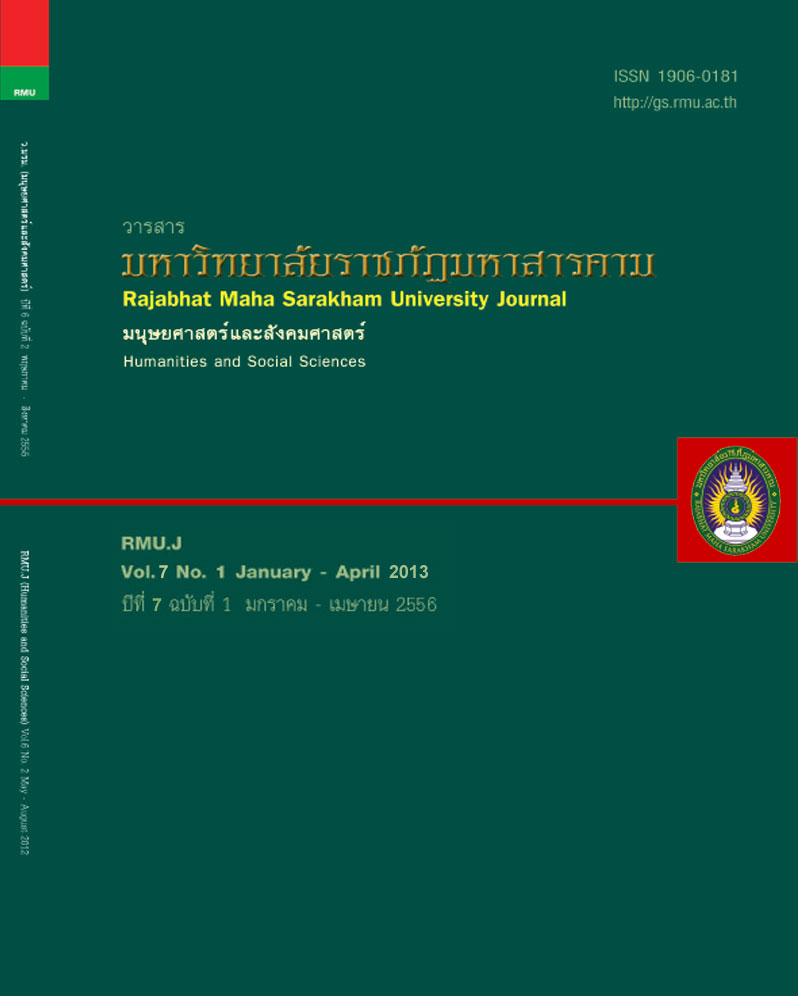รูปแบบการป้องกันยาเสพติดในสถานศึกษาสังกัดอาชีวศึกษา ในภาคอีสานตอนล่าง
Main Article Content
บทคัดย่อ
บทคัดย่อ
การวิจัยครั้งนี้มีวัตถุประสงค์ ประการแรก เพื่อศึกษาการปฏิบัติในการป้องกันยาเสพติดของบุคลากรอาชีวศึกษาในภาคอีสาน ตอนล่างในหกด้านได้แก่ ด้านการให้การศึกษา ด้านการประชาสัมพันธ์ ด้านกิจกรรมทางเลือก ด้านการฝึกทักษะชีวิต ด้านการใช้ กิจกรรมกลุ่มเพื่อน และด้านการปรับสภาพแวดล้อม ประการที่สอง เพื่อเปรียบเทียบการปฏิบัติการป้องกันยาเสพติดในสถานศึกษา ตามความคิดเห็นของบุคลากรสังกัดอาชีวศึกษาในภาคอีสานตอนล่างทั้งหกด้าน และประการที่สาม เพื่อสร้างรูปแบบการป้องกันยาเสพติด ในสถานศึกษาสังกัดอาชีวศึกษาในภาคอีสานตอนล่าง กลุ่มตัวอย่างที่ใช้ในการวิจัยประกอบด้วยผู้บริหาร และครูฝ่ายปกครอง จำนวน 205 คน ผู้เชี่ยวชาญ จำนวนหกคน และบุคลากรที่เป็นผู้บริหาร และครูในสถานศึกษาที่ปฏิบัติการป้องกันยาเสพติดได้ดี จำนวน 280 คน เครื่องมือที่ใช้ในการเก็บรวบรวมข้อมูลเป็นแบบสอบถาม จำนวนสองฉบับ และแบบสัมภาษณ์หนึ่งฉบับ สถิติที่ใช้ในการ วิเคราะห์ข้อมูล ได้แก่ ค่าร้อยละ ค่าเฉลี่ย ค่าความเบี่ยงเบนมาตรฐาน การทดสอบค่าที และการทดสอบค่าเอฟ ผลการวิจัย พบว่า
ยาเสพติดที่พบในสถานศึกษาโดยเรียงลำดับจากมากไปน้อยได้แก่ บุหรี่ เหล้า ยาบ้า กัญชา กาวและทินเนอร์ การปฏิบัติการ ป้องกันยาเสพติดในสถานศึกษาโดยรวม รายด้าน และรายข้อ อยู่ในระดับปานกลาง บุคลากรที่มีตำแหน่ง และประสบการณ์ต่างกัน มีความคิดเห็นต่อการปฏิบัติการป้องกันยาเสพติด โดยรวมแตกต่างกัน เพศ และขนาดสถานศึกษาต่างกัน มีความคิดเห็นต่อการ ปฏิบัติการป้องกันยาเสพติด โดยรวมไม่แตกต่างกัน รูปแบบการป้องกันยาเสพติดในสถานศึกษาสังกัดอาชีวศึกษาในภาคอีสานตอน ล่าง ที่มีความเหมาะสมในหกด้านเรียงตามลำดับดับ ความสำคัญดังนี้คือ ด้านการปรับสภาพแวดล้อม ด้านกิจกรรมทางเลือก ด้าน การใช้กิจกรรมกลุ่มเพื่อน ด้านการให้การศึกษา ด้านการฝึกทักษะชีวิต และการประชาสัมพันธ์
คำสำคัญ : รูปแบบการป้องกันยาเสพติด, อาชีวศึกษา, ภาคอีสานตอนล่าง
ABSTRACT
The purposes of this research were: Firstly, to study narcotics prevention practice of personnel in vocational institutions in the lower northeast in six aspects: educational provision; public relations; alternative activity, life skills training, peer-group activity, and environmental adjustment, secondly, to compare the narcotics prevention practice in vocational institution as perceived by personnel in vocational institutions in the lower northeast in all six aspects, and thirdly, to create the model of narcotics prevention practice in vocational institutions in the lower northeast. The subjects used for this research were 205 administrators and discipline teachers including 6 experts and also 280 personnel who were working as administrators and teachers who had worked with good narcotics prevention practice. The instruments used for collecting data were two copies of questionnaires, and one interview form. The statistics used for analyzing the data were percentage, mean, standard deviation, t-test, and F-test.
The research findings revealed the narcotics categories found in the vocational institutions ranging in the order of quantity were cigarettes, spirits, amphetamine, marijuana, glue, and thinner vapors. The narcotics prevention practice in vocational institutions was rated at the moderate level as a whole and an individual. The overall opinion of personnel with different positions and experiences towards narcotics prevention practice was significant difference. The gender and institution size were not significant difference. The model on narcotics prevention practice in vocational institutions in the lower northeast had appropriateness in six aspects difference from high to low: environmental adjustment, alternative activity, peer-group anxiety, educational provision, life skills training, and public relations.
Keywords : a model of narcotics prevention, vocational institutions, the lower northeast of Thailand
Article Details
1. บทความที่ลงตีพิมพ์ทุกเรื่องได้รับการตรวจทางวิชาการโดยผู้ประเมินอิสระ ผู้ทรงคุณวุฒิ (Peer Review) สาขาที่เกี่ยวข้อง อย่างน้อย 3 ท่าน ในรูปแบบ Double blind review
2. ข้อคิดเห็นใด ๆ ของบทความที่ลงตีพิมพ์ในวารสารมหาวิทยาลัยราชภัฏมหาสารคาม นี้เป็นของผู้เขียน คณะผู้จัดทำวารสารไม่จำเป็นต้องเห็นด้วย
3. กองบรรณาธิการวารสารมหาวิทยาลัยราชภัฏมหาสารคาม ไม่สงวนสิทธิ์การคัดลอกแต่ให้อ้างอิงแสดงที่มา

